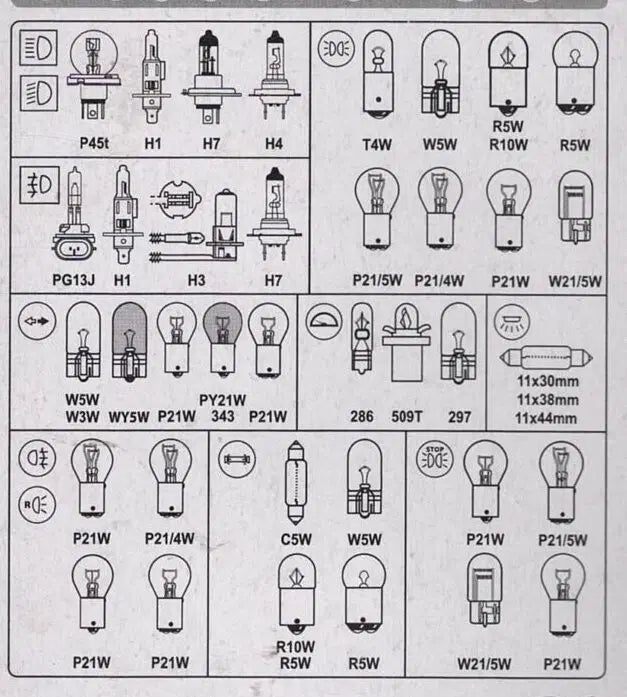Xenon, LED, halogen, diodes – What's the difference?
There are several different lighting technologies today that you often hear about, but what is the actual difference between them? See the answer here and see the advantages and disadvantages.

Technical description of different lighting technologies
What does IP rating mean?
The IP rating is a measure of how well the equipment resists moisture, dust and accidental contact. Read more about IP ratings here.
The IP rating is not a measure of quality, although high tightness usually means that the equipment is well built.
Lumen, what does it mean?
Lumen is, in short, a measure of the total amount of light that a light source emits. The measurement is not affected by differences in light pattern, but a lamp with a narrow light flux is perceived as brighter than a lamp with a wide light flux, as the amount of light at a given point is higher (this is measured in lux). The light pattern is therefore just as important as the amount of light when choosing the right lamp.
Lux, what does that mean?
Lux is a measure of the total amount of light that hits an area of 1 square meter, one lux corresponds to one lumen per square.
A lamp with a long, narrow beam will provide a higher lux rating than a lamp with a wider beam, even if the total amount of light (in lumens) is identical. What is best will of course vary depending on the intended use.
Plastic lens or glass lens, what's the difference?
Lenses for LED lights are often made of plastic, normally PMMA (Polymethyl methacrylate, also known as Plexiglas, Bonoplex and Perspex) or PC (Polycarbonate, also known as Lexan, Makrolon and Hammerglass).
Lenses for halogen and xenon lamps are normally made of tempered glass.
Halogen, Xenon or LED, which technology is best?
Which light source is best suited varies depending on the area of application; all technologies have their advantages and disadvantages.
Halogen
Halogens are a group of noble gases, and lamps with mixtures of these gases (usually Iodine or Bromine) have been dominant as a light source in work lighting and car headlights since the 1970s. Compared to a regular incandescent lamp, a Halogen lamp lasts 2-4 times longer, and provides a greater amount of light with the same energy consumption. Color temperature about 3000°K (yellowish).
Advantages:
Cheap to purchase.
Quick ignition.
Disadvantages:
Sensitive to vibrations, shocks and impacts.
Relatively short lifespan (about 500 hours under good conditions).
Gas discharge lamps, Xenon lamps, HID, High Intensity Discharge
Gas discharge lamps are a group of lamps that, through electrical action, ionize noble gases into a luminous plasma. The gas is most often Xenon (pronounced Se-nåån), but Argon, Neon and Krypton are also found.
In vehicles, Xenon is used as the main gas, hence the common name “Xenon lamps.” These lamps became common during the 90s, and are today the most common light source on larger construction machinery, forestry machinery and trucks.
Color temperature normally between approximately 4300°K (white) and 14,000°K (blue)
Advantages:
A xenon lamp is less sensitive to vibrations and shocks than a halogen lamp.
Provides approximately 3 times higher light output than halogen lamps.
Relatively long lifespan (about 5000 hours under good conditions).
Disadvantages:
Higher costs for service parts.
High power consumption at startup.
Approximately 10 seconds before full brightness is reached.
The cheapest brands can cause problems when starting in severe cold, as well as radio interference.
LED ( LEDs, Diodes, Light Emitting Diodes )
Over the past few years, LED technology has matured and developed to the point where it has become a serious alternative to Halogen and Xenon lamps. Prices have steadily fallen as manufacturing volumes have increased.
Each diode has its own reflector, and the design of an LED headlight is designed to be completely different from what has previously been “standard.” The electronics are normally completely encapsulated in epoxy, making it extremely weatherproof.
An LED lamp contains no moving parts, and if properly designed, it will last longer than the machine it is mounted on.
Color temperature normally about 6000°K (cool white).
Advantages:
Very long lifespan (about 50,000 hours under good conditions).
Basically insensitive to vibrations, very resistant to shocks and impacts.
Low heat generation.
Instant start-up.
Often multivolt, 9-32v.
Disadvantages:
Individual components cannot normally be replaced as the electronics are often molded in.
Cheaper brands do not achieve the theoretical lifespan, often due to insufficient cooling or poor quality components.
CCFL
Cold Cathode Flourescent Lamp / Tube, or CCFL / CCFT, is a technology used in neon tubes, among others. Common as backlighting of LCD screens and as
accent lighting on some vehicles.
The technology has been largely replaced by light-emitting diodes (LEDs) for a few years now, and is in decline.
Advantages:
Unbroken light string, does not give the “dotted” appearance that diodes often give.
Low heat generation (however higher than LED).
Disadvantages:
Higher power consumption and weight than LED.


